Strengthening the Eyes
by Bernarr A. MacFadden, Strengthening the Eyes; A System of Scientific Eye Training.
CHAPTER XXI
Exercises for Constitutional Improvement
THE value and necessity of exercise as a factor in constitutional improvement has already been pointed out. Every one needs a proper amount of exercise for the sake of the general health, irrespective of the effect upon his eyes.
Without going too deeply into the physiology of exercise, it may be said that there are two general results to be gained from any good system of physical training. In other words, exercise may affect one in two ways. It may have chiefly a muscle-building value. Or it may have what is commonly called a constitutional or health-building value. Muscle-building exercises are intended chiefly to build strength and enlarge the muscles. Constitutional exercises chiefly affect the heart, the lungs, the vital organs generally, and, in consequence, the purity and quality of the blood.
Now, nearly all exercises partake of this twofold purpose. They strengthen and enlarge the muscles and, at the same time, they build up the general health through their effect upon the heart and lungs, the digestive and eliminative systems. That is why almost any form of activity, if one secures enough of it, is likely to fulfill all requirements in both these respects. At the same time there are some exercises which are particularly of the muscle-building type and are only slightly constitutional in their influence. There are others which have only a small muscle-building value, being useful mainly because of their effect in toning up the vital organs.
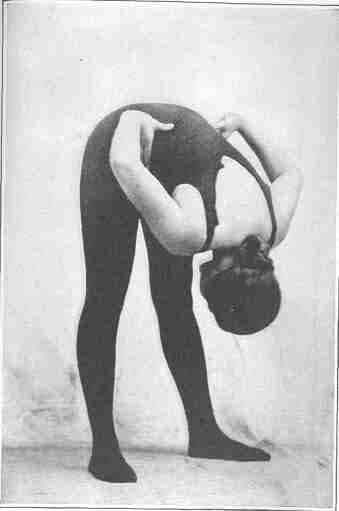
Exercise 1.—With the hands at the hips bend far forward in the manner illustrated. Repeat five or ten times according to strength. It is best to commence with a few repetitions and increase the number with the increase of strength.

Exercise 2.—Bend well backward in the manner illustrated. It is usually most convenient to combine exercises 1 and 2 in one movement. Repeat as desired.
All those types of exercise which call for endurance are of the greatest value from a constitutional standpoint. In other words, any exercise which may be continued for a considerable length of time and which, therefore, keeps the heart working energetically and causes one to breathe deeply and freely during that period, will inevitably tone up the internal organs.
The shallow breathing of the inactive man or woman is not calculated to fill the blood with oxygen, and the brain and all of the structures of the body suffer more or less from the lack of this life-giving element. Exercises which cause prolonged deep breathing will naturally increase the oxygen intake until your entire body from top to toe is literally charged with it. This will make you more alive. It will make you brighter and more energetic, and the improved circulation will tend to tone up every cell and every structure of the body.
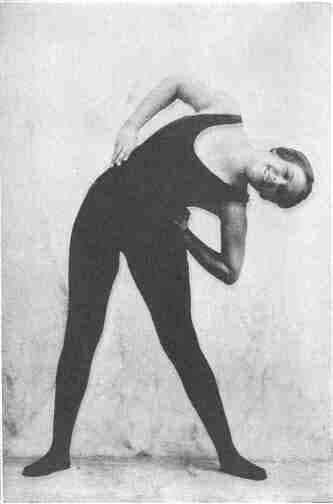
Exercise 3.—With feet well apart to give a better base of support, bend the body far sideways, to both sides, five or ten times.
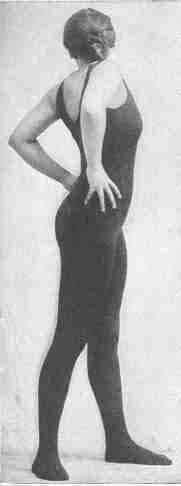
Exercise 4.—Twist first far to one side then far to the other. This is a spine-twisting and organ-stretching movement. The more action, the better.

Exercise 5.—Fingers extended, stretch vigorously upward, lower arms, then stretch upward again. Vary by stretching forward and sideways.
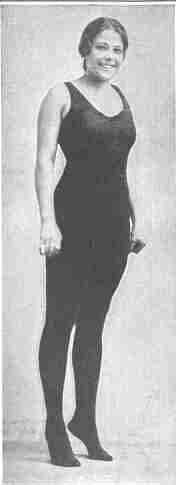
Exercise 6.—Raise the body high on the toes as illustrated. If too easy, do it on one foot at a time.
It is for this reason that a long walk is one of the best of all forms of constitutional exercise. Every time you step you lift the weight of your entire body and move it the distance of your stride. Although there may be little effort in walking, nevertheless considerable energy is consumed, and the largest muscles of the body are brought into play. It is because walking is accomplished by the largest muscles that the effort seems easy. Nevertheless it calls for a large supply of blood and of oxygen. This means increased circulation and deeper breathing. Walking for a distance, therefore, means the continuation for a period of time of moderate exercise for the body's largest muscles, without involving any strain. There is the very least expenditure of nerve-force in proportion to the physiological benefit.
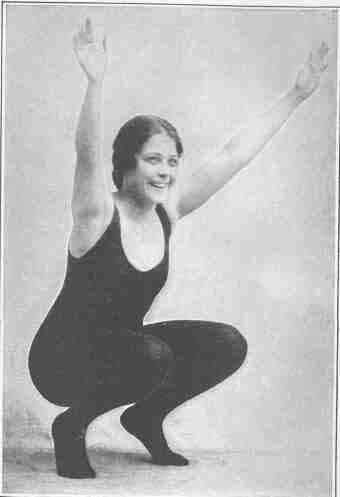
Exercise 7.—Starting in a standing position with the arms at the sides, bend the knees and lower the body to the squatting position. It is easier to maintain balance and requires less effort if the arms are swung forward and upward as the body is being lowered, as illustrated.
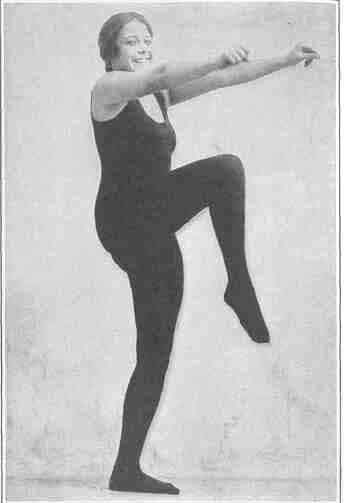
Exercise 8.—Bring one knee at a time upward as high as possible with a snappy, kicking movement. A little more action is secured by swinging the arms upward at the same time. Repeat five or ten times or more with each leg.

Exercise 9.—Lying on the back with arms folded, raise body to a sitting position. Repeat according to strength and fatigue. If necessary, use a weight over the feet.
There are other forms of constitutional exercise which do not involve any severe strain upon the muscles, and which are beneficial largely because of their endurance-building quality. Cycling at moderate speed, hill climbing, rowing for pleasure, horseback riding, golf, gardening, and other varieties of exercise, may be included in this class. Of course, some of these, like gardening or rowing, may be made very strenuous indeed if one wishes to exert oneself.
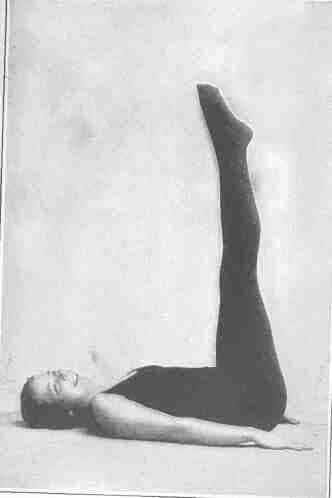
Exercise 10.—Lying on the back with the arms at sides, raise the legs to the perpendicular pisition illustrated. Repeat as desired.
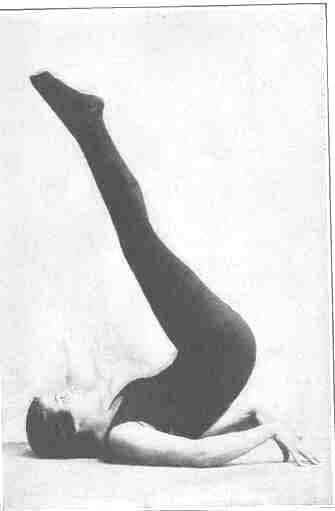
Exercise 11.—This is a variation and extension of the preceding movement. It is a little more vigorous hut also more interesting. Continuing the preceding movement, raise the hips and back from the floor as illustrated.
The exercises which we are illustrating herewith are useful both for their constitutional and their muscle-building value. They are particularly designed to keep the trunk of the body firm, strong and vigorous. Exercises that bend and twist the trunk of the body not only build up and strengthen the external muscles, thus supplying the lower trunk with strong, firm muscular walls, which prevent any prolapses or sagging of the internal organs, but they indirectly affect the internal organs, toning them up and making them far more vigorous. They also help to keep the spine and its cartilages strong, flexible and youthful.
Either the system of exercise presented herewith, or any other system which answers the same purpose, should be practiced at least once each day. It will be best to take the movements in your bedroom before dressing. If taken in the morning, they will wake you up and warm you up, so that a cold bath will be not an ordeal but a pleasure. You will find it advantageous to give the skin of the entire body a brisk rubbing following the exercises and preceding your bath. If you do not find it convenient to take the exercises in the morning, however, they may be taken either late in the afternoon or in the evening—a half hour before retiring.
Special attention is called to the exercises for the neck which are illustrated. There are two ways in which they are especially valuable: first, in improving the circulation about the neck and head; and second, in improving the upper spine, or, to be more exact, the cervical spine.
The question of active circulation is always important. These neck exercises will not only affect the neck itself, strengthening and building up th eneck muscles, but they will improve the circulation throughout the head because of the quantity of blood sent in this direction in response to the exercise.
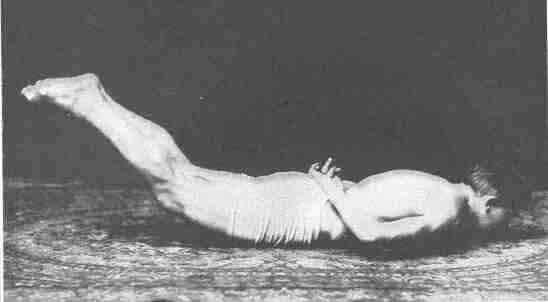
Exercise 12.—Lying prone with hands behind the back, raise feet and, if possible, the entire length of both legs as high as possible. This Involves the muscles of the lower region of the back and the hips.up the neck muscles, but they will improve the circulation throughout the head because of the quantity of blood sent in this direction in response to the exercise.
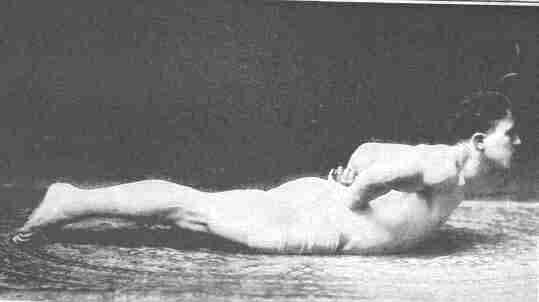
Exercise 13.—Again lying prone, raise the head and shoulders as high as possible as illustrated This involves the muscles of the middle and upper back.
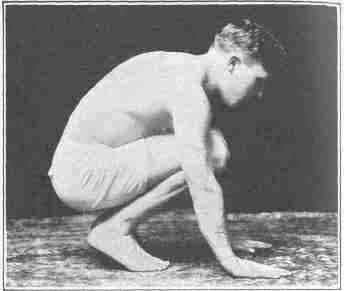
Exercise 14.—Starting from a standing position, bend down and place the hands on the floor in the manner illustrated. Then with a jumping movement, kick the feet back until the body is straight with the weight on hands and feet. (See next photo.)
Congestion about the neck is known to produce a "fullness" in the head with consequent congestion in and about the eyes. Measures which relieve this condition will naturally tend to lessen the strain upon the eyes themselves, making for more perfect and easier sight.
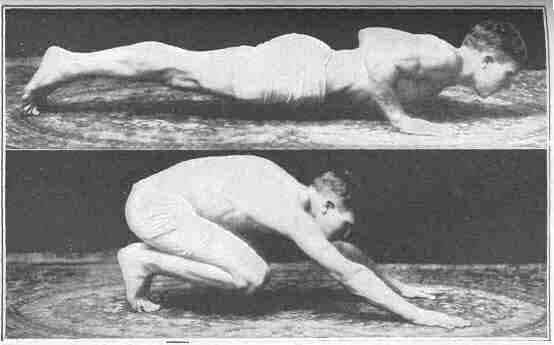
Exercise 15 and 16.—Next lower the body as shown in the upper photo. Push up and repeat until slightly tired. A variation is shown in lower photo. Keep arms stiff, straighten the legs, projecting the body forward with head well in front of supporting position of hands. Swing back, repeat.
Deep breathing, water drinking and relaxation, as well as exercise, are useful for this purpose. Conscious relaxation of the neck muscles with deep breathing will often relieve congestion in the head very quickly, but active exercise promoting a vigorous circulation is one of the most effective means known for overcoming either a state of congestion or an anemic condition of any part of the body.
These neck exercises will also tend to keep the upper spine flexible and in normal alignment. Exercise for spinal strength and flexibility is, perhaps, even more important, generally speaking, than exercise for muscular development, for the reason that the spine would otherwise tend to become rigid, and the little cartilages or cushion-like disks between the vertebræ? hardened and compressed. Exercise will prevent this, keeping these cushions elastic and healthy. Furthermore, any displacement of the vertebræ causes a pinching of the spinal cord, or spinal nerves, and consequent interference with the currents of nerve force, with more or less derangement of various functions of the body. Osteopaths claim to accomplish very marked results in many cases of eye trouble through the proper mechanical adjustment of the spine and the freeing of the nervous impulses. Proper neck exercise will prevent adhesions of the vertebræ and tend to keep the upper spine in such perfect alignment that the spinal cord is free from any disturbing factors of this kind.
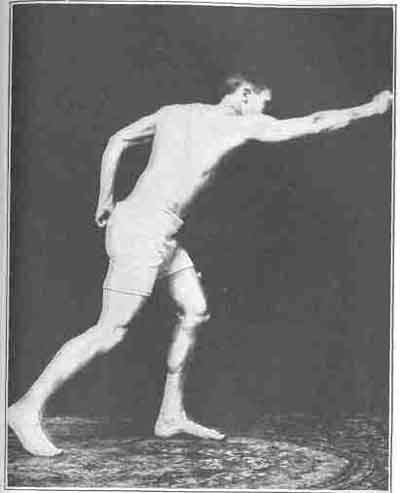
Exercise 17.—A vigorous and stimulating exercise is found in shadow boxing as shown in the above photo. Strike out forward vigorously first with one fist and then with the other, continuing to alternate until slightly tired.

Exercise 18.—The "stationary run." A running action without going forward. A splendid constitutional exercise, inducing free respiration and perspiration. Excellent for finishing up any type of indoor exercise.
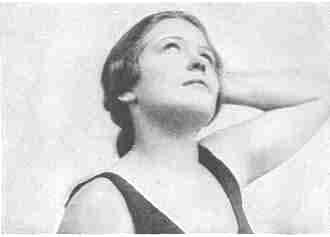
Exercise 19.—A neck resistance exercise. Placing one hand back of the head, bring the head backward, resisting the movement with the hand in the manner illustrated. Five to ten movements.
If you have not been accustomed to muscular exercise, a word of caution is necessary in order that you may not overdo the work the first day, and thereby produce a condition of lameness and stiffness of the muscles that is likely to be very discouraging. Enthusiasm in the beginning may lead one to take too much exercise. It is best to try only about half as much as you think you could comfortably do to start with. Never carry any exercise to the point of pronounced fatigue. As you get stronger you can increase the vigor of your movements.
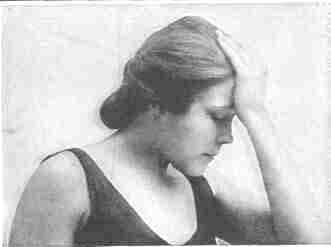
Exercise 20.—Neck exercise. Place hand against forehead and bring head forward and downward against resistance.
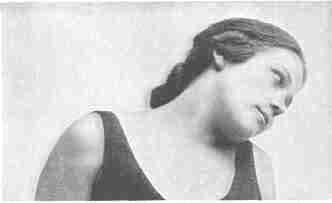
Exercise 21.—A simple neck exercise. Bring the head first far to one side, then to the other, placing it upon the shoulder on each side. Vary by a head-circling movement, and neck-twisting movement.
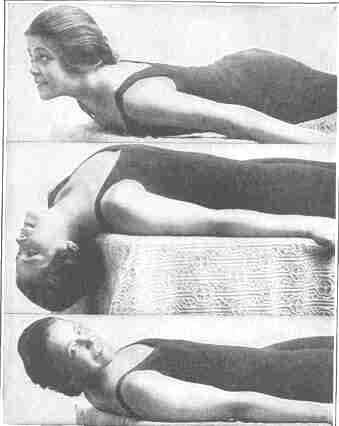
Exercise 22, 23 and 24.—In this series of free movement neck exercises, the horizontal position is assumed so as to secure the natural resistance provided by the weight of the head. In the first position, lying upon the stomach, the head is first lowered as far as possible and then raised high, as in the upper photo. In the next exercise, lying on the back, the head is first lowered as shown, and then raised straight upward and brought over the chest. In the last exercise (lower photo), the raising of the head is combined with a head-turning or neck-twisting action, very valuable for its effect upon the vertebrae of the upper spine.
If you should experience any lameness or stiffness of the muscles, the local application of hot water, or a complete hot bath, will give relief, especially if followed by energetic rubbing of the parts. In any case, the soreness will disappear in a few days and should not prevent your continuing with the exercise.
It is, of course, understood that all exercises will be taken with the windows open, so that you may have the advantage of fresh, pure air. Much of the benefit of your exercise will be lost if you breathe stale or stagnant air while you are taking it. Much of the benefit and energy that you derive from your exercises will also depend upon how much energy you put into them. Exercise vigorously. Put life, vim, determination into every movement. Ten or fifteen minutes energetically spent in these exercises will keep you vigorous and fit.
In addition, try to spend at least two or three hours a day in the open air. It may be well to start with a walk of one or two miles. Then increase the distance by a quarter of a mile each day until you are covering anywhere from five to six miles and upward. If in addition to the vigor-building exercises which are illustrated you will make it a point to take at least one good walk each day, you will have established for yourself an ideal scheme of physical culture.
| Eyes carePhysicianBate's booksTechnologyForumLaser corre.Blues under eyesburning in the eyesanother diseasesMedical mistery Naturally eyesight correction. No laser eye surgery. Restore eyesight. Vision correction. |




